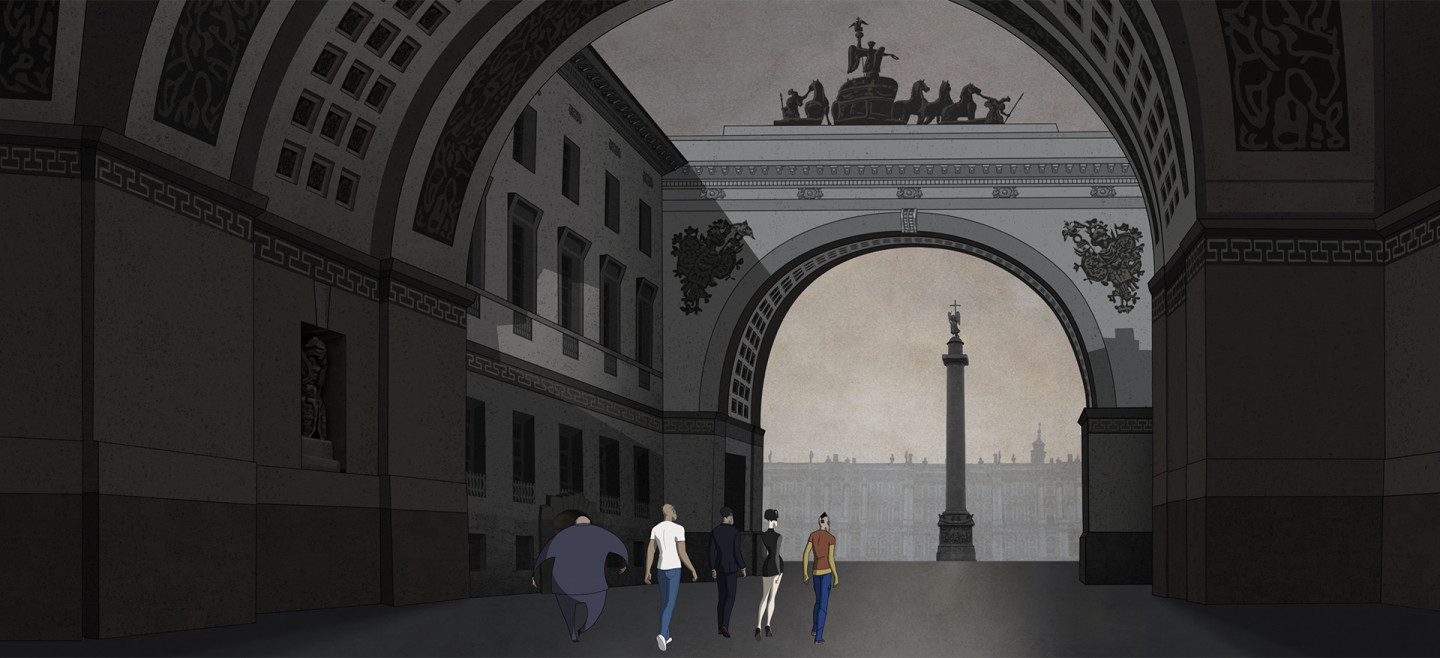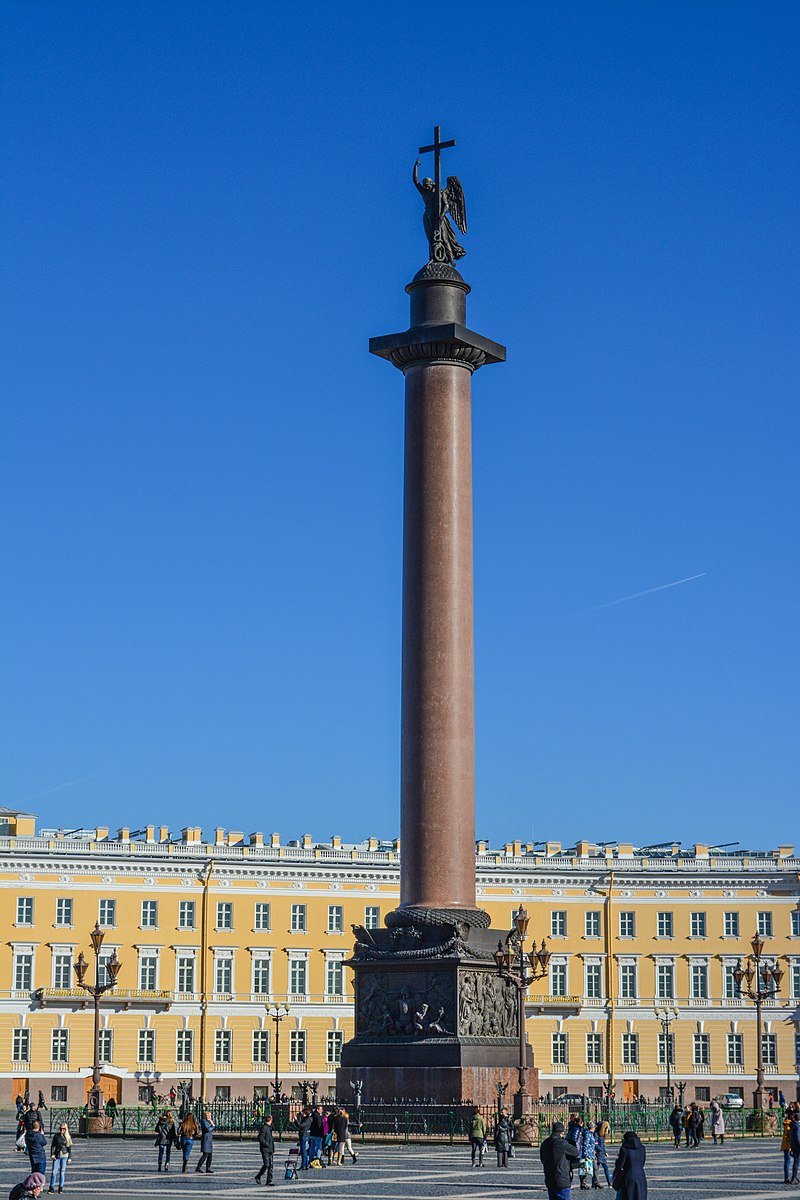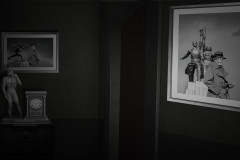Sándor-oszlop, Szentpétervár, Palota-tér, 1830-34 (gránit, 47,5 m magas). Amikor Ruben Brandt műkincsrablói egy Gauguin-képért az Ermitázs felé tartanak, már messziről feltűnik az egykori uralkodói központ, a Palota-tér legfőbb ékessége, az 1812-es Napóleon felett aratott győzelem emlékére emelt oszlop. A világ legnagyobb egy kőtömbből álló oszlopát az Oroszországban dolgozó francia építész, Auguste de Montferrand tervezte.
Az oszlopállítás szokása igazából már az őskorban elkezdődött, amikor óriási, faragatlan kőtömböket (menhíreket) állítottak az emberek szellemeik, őseik vagy valójában nem nagyon tudjuk, kinek-minek a tiszteletére. Az egyiptomiak szabályosra faragott oszlopai, obeliszkjei a Napistent dicsőítették, ezeket a rómaiak, majd később Napóleon is előszeretettel hurcolták el saját hazájukba, s állították fel főtereiken. De a rómaiak saját uralkodóik tiszteletére is emeltek diadaloszlopokat és a 19. század eleji klasszicizmus, amelynek idején a szentpétervári Sándor-oszlop is készült, pont ezt az antik hagyományt eleveníti fel. „I. Sándornak a hálás Oroszországtól” - olvasható a domborművekkel is díszített talapzaton, hiszen ő volt az uralkodó a győzelem idején. Az oszlop tetején a Borisz Orlovszkij által készített, kezében keresztet tartó angyal látható, akinek arcvonásai állítólag nagyon hasonlítanak Sándor cárra. A 25,45 m magas, 3 méter átmérőjű, 600 tonnás vörös gránittömböt Szentpétervártól északra fejtették, s egy külön erre a célra készült teherhajóval szállították a városba. A felállításán 2500 férfi dolgozott, s olyan tökéletesen sikerült a helyére emelni, hogy saját súlyánál fogva megtartja magát, másként nincs is rögzítve. A szentpéterváriak azért egy ideig rettegtek, hogy rájuk fog dőlni az oszlop, az anekdota szerint Montferrand élete végéig minden nap körbejárta, hogy bebizonyítsa, senkinek sincs félnivalója.
Budapest egyik főterén is van egy magas talapzaton álló oszlop, angyallal a tetején (a Ruben Brandtban is benne van!) Tudod, hol?
Alexander Column, Palace Square, St. Petersburg, 1830–34 (granite, 47.5 m tall). As Ruben Brandt’s team of art thieves heads toward the Hermitage to steal a Gauguin painting, one of the first landmarks we see is the majestic centerpiece of the former imperial capital’s Palace Square: a monument erected to commemorate Russia’s victory over Napoleon in 1812. The world’s tallest column carved from a single stone was designed by the French architect Auguste de Montferrand, who worked extensively in Russia.
The tradition of raising columns dates back to prehistoric times, when massive, uncarved stone slabs (menhirs) were erected—though for whom or what purpose remains uncertain. In ancient Egypt, carefully shaped columns and obelisks honored the sun god; later, the Romans—and even Napoleon—transported these monuments to their own capitals as symbols of power. The Romans also built triumphal columns to glorify their emperors, a custom revived during the neoclassical period of the early 19th century—when the Alexander Column was erected in St. Petersburg. “To Alexander, from grateful Russia” reads the inscription on the base, which is also decorated with reliefs, honoring Tsar Alexander I, who ruled at the time of the victory.
Atop the column stands an angel holding a cross, sculpted by Boris Orlovsky. According to legend, the angel’s face resembles that of Tsar Alexander. The 25.45-meter-high, 3-meter-wide, 600-ton red granite monolith was quarried north of St. Petersburg and transported on a specially designed barge. Its installation involved 2,500 workers and was so precise that the column stands upright solely under its own weight—it is not otherwise fixed in place. Still, locals reportedly feared it might topple, and legend has it that Montferrand walked around the base daily until his death to reassure them.
There’s a similarly striking column topped with an angel in one of Budapest’s main squares (it even appears in Ruben Brandt, Collector!). Do you know where it is?







































